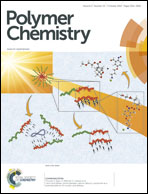Ultra-sensitive detection of explosives in solution and film as well as the development of thicker film effectiveness by tetraphenylethene moiety in AIE active fluorescent conjugated polymer†
Abstract
A fluorescence sensory polymer (P1) consisting of pentiptycene and tetraphenylethene (TPE) units linked by acetylene was synthesized for direct detection of explosives in solution and air. At the same time, the effectiveness of thicker film in the presence of the TPE moiety for the detection of explosives was investigated. Fluorescence turn-off detection of picric acid (PA) was carried out in H2O–THF mixture containing 90% water, where the TPE units of the polymer are in a highly emissive aggregation state. Polymer P1 exhibits a fluorescence quenching response of 24% with addition of 4.36 × 10−8 M PA and 98% with the PA concentration at 4.7 × 10−6 M. For a thinner film (4 nm) of P1 after exposure to dinitrotoluene for 10 s, the fluorescence intensity dropped 48% and it continued to drop 97% after 300 s, the corresponding values being 29% and 72% for thicker film (75 nm), respectively. These results indicate that P1 is a promising material for direct detection of nitro explosives in air and solution at ppb levels, and the TPE moiety inside the polymer improves the sensitivity and effectiveness of thicker films.


 Please wait while we load your content...
Please wait while we load your content...